Spooky Trees, San Angelo State Park
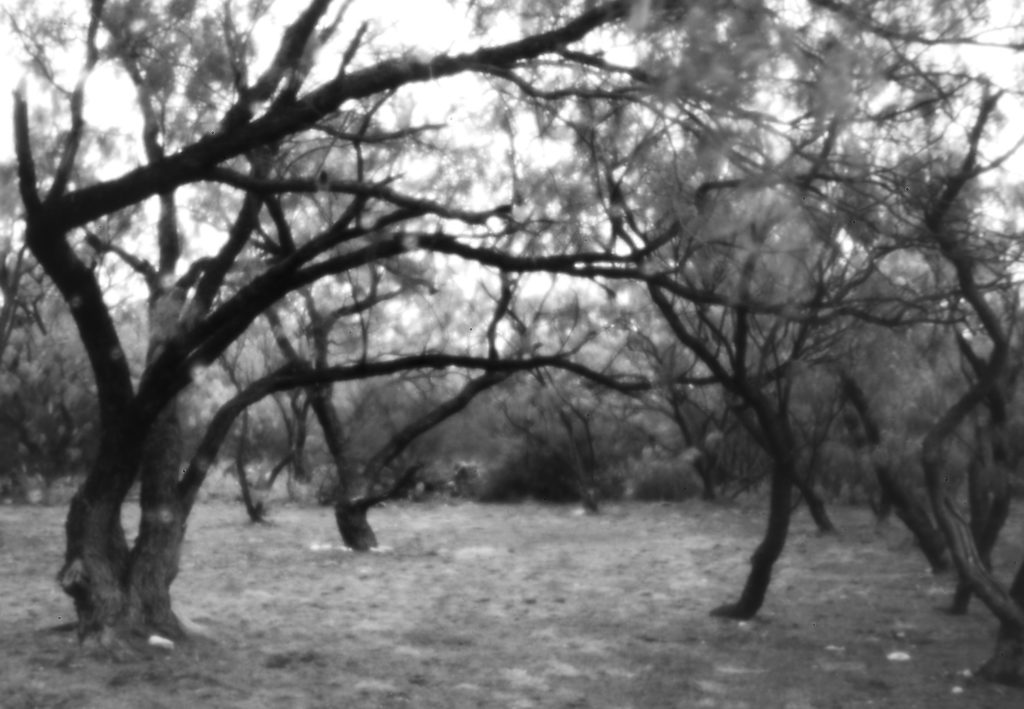
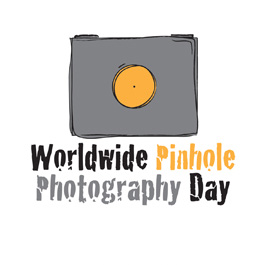
Worldwide Pinhole Photography Day “is an international event created to promote and celebrate the art of pinhole photography.” It is held each year on the fourth Sunday in April. In 2022, that was April 17. The idea is to make a pinhole photograph on the appointed day and upload a digital version to the year’s gallery. This was my mission on April 17, 2022.
April 17 dawned a bleak and drizzly spring day in San Angelo. Kathryn and I set out to Angelo State Park thinking we could find some targets of opportunity. We knew the park had lots of trees, a lake, some streams, buffalo, longhorns, spring flowers and other potential subjects. So off we went and arrived just a few minutes after the gates opened.
The final product is the photograph above, “Spooky Trees, Angelo State Park.” To see my submission in the Worldwide Pinhole Day Gallery, click here. My submission was #678 and is the only one from San Angelo, Texas.
Pinhole Zoom “Lens”
For our expedition, I used the Thingyfy Pinhole Pro X, which is a 40mm to 60mm zoom pinhole. I used this pinhole lens for my previous Worldwide Pinhole Photography Day outing in 2020. Note: A pinhole is not a lens, since there is no glass and it’s just a hole. However, the Pinhole Pro X looks like a lens, has an EF mount and attaches to the camera like a lens, and zooms. As a compromise, I’m calling this a pinhole lens (How about “pinholens?” No?) Here’s a shot of the Pinhole Pro X:
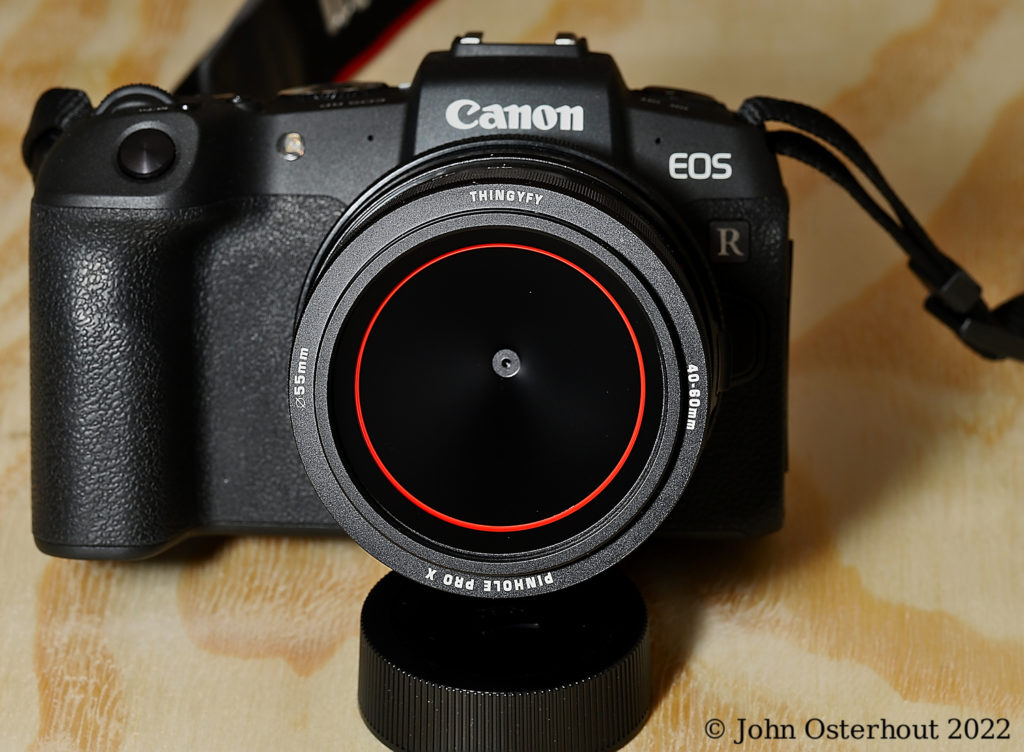
The central divot you see in the Pinhole Pro X is not the pinhole. The pinhole is inside the divot and measures 0.25 mm. Note that I’m using the Canon EOS RP body. This is a full-frame mirrorless camera that uses RF mount lenses. To use the Pinhole Pro X, I have to use an adapter.

Here is the setup, from bottom: Canon EOS RP, Canon Control Ring Mount Adapter EF-EOS R, and the Pinhole Pro X. Note in the photo that the Pinhole Pro X is set to 40mm. It zooms to 60mm. The pinhole is mounted in a helicoid. When you twist the zoom ring the pinhole moves from 40mm to 60mm from the sensor resulting in a zoom pinhole.
Let’s Talk f Numbers and Exposures (Warning: Geeky)
The f number of a lens (AKA f stop) is the focal length (FL) divided by the entrance pupil (D, for diameter), f = FL/D. The f number of the Pinhole Pro X at 40mm is 40mm/0.25mm = 160. At 50mm and 60mm the f numbers are 200 and 240 respectively. Compared to a normal lens, not much light is coming through that pinhole!
How does one cope with the exposure? It turns out that the RP will meter the exposures in daylight just fine. For the image at the top, I used ISO 100 and bracketed the exposures from about 5 seconds to 30 seconds, which is the maximum the RP will allow.
What if your camera can’t or won’t meter through the pinhole? I brought along my Gossen Digisix handheld meter just in case. Here’s an example. Suppose your handheld meter says f/16 at 1/100 second using ISO 100 (you might recognize this as the Sunny Sixteen condition). Now, assume we are using 50mm on the Pinhole Pro X. The f number is 200 as calculated above. Here is a formula to calculate the exposure time:

Where fph is the f number of the pinhole (200 in this case), fm is the f number indicated by the meter (16 in this case), tm is the time indicated by the meter (1/100 s = 0.01 sec in this case) and texp is the exposure time you should use. Here is the calculation with the numbers:

So our calculation says to expose for 1.56 sec under these conditions. These conditions represent bright sunlight. Your mileage may vary. If you are shooting digital you don’t have to worry about reciprocity failure, but if you are using film or exposing photo paper directly then worry you must. Now back to the regularly scheduled program.
Tower by the Dam
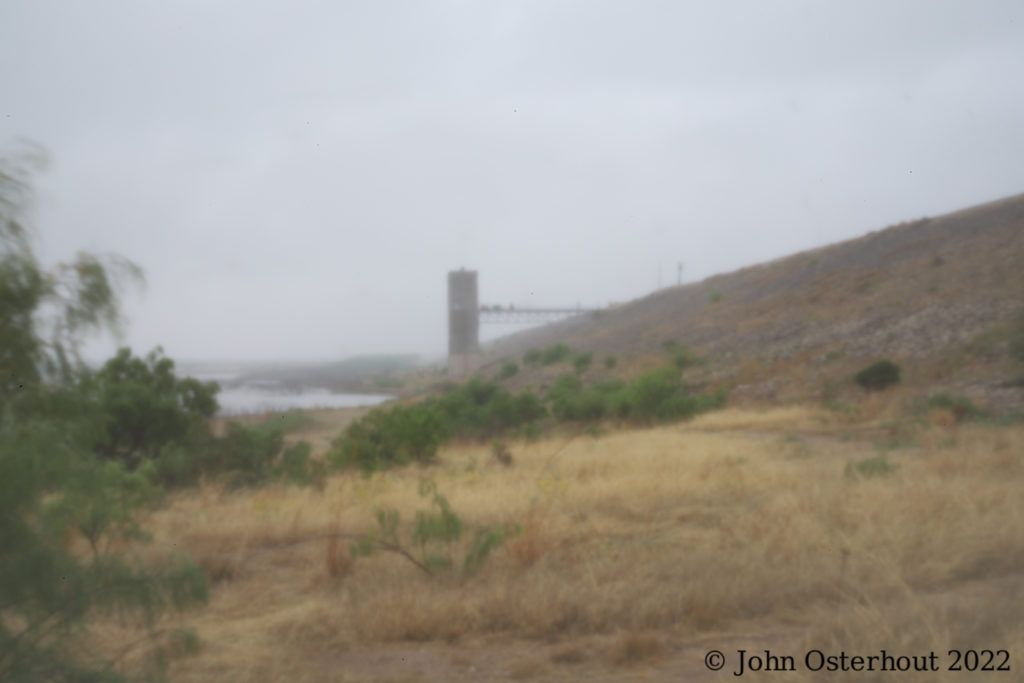
Here is a shot of a structure jutting out from the O. C. Fisher Reservoir dam. I thought it looked cool. It looks a little like a wizard’s tower or a castle turret This shot was taken with the Pinhole Pro zoomed all the way out to 60mm. Gee, I wish I could zoom in some more…
Wait! I was packing a set of Kenko extension tubes. I got these for poor man’s macro photography. The Kenko set has tubes of 36mm, 20mm, and 12mm for a total of 68 mm. Combined with max zoom on the Pinhole Pro X this gives a “focal length” of 128 mm. Cool, eh? Here is a picture of the setup.
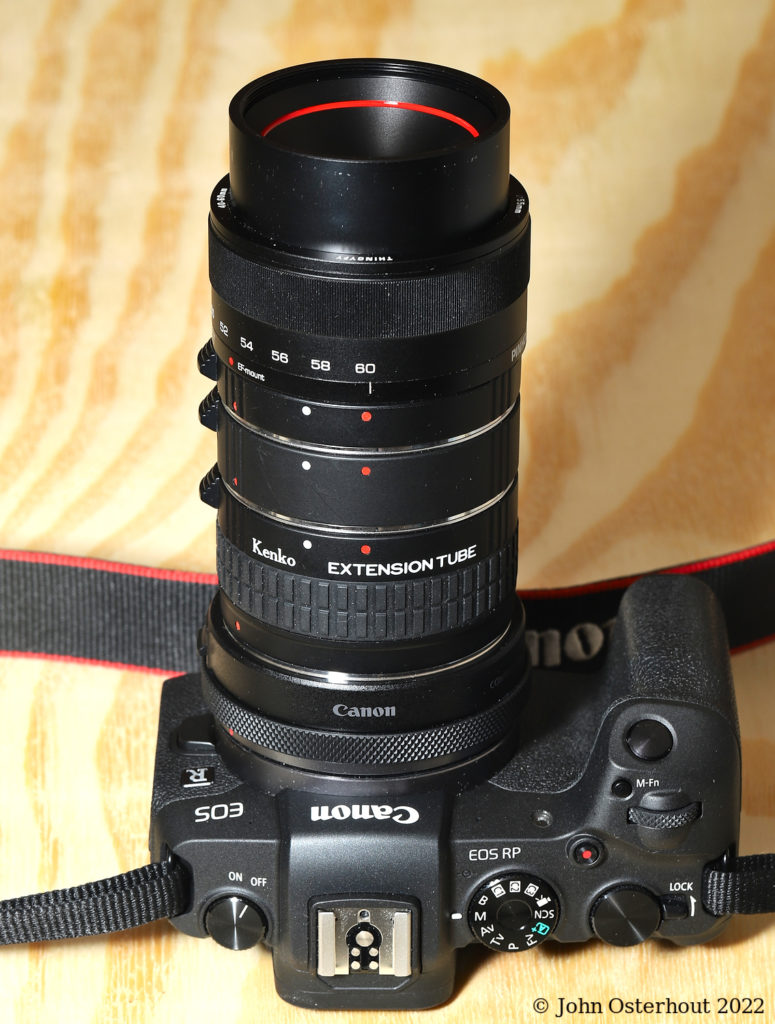
From the bottom: Canon EOS RP, the Canon Control Ring Mount Adapter EF-EOS R, the three Kenko extension tubes, and the Pinhole Pro X set to 60mm. The f number of this setup is 128/0.25 = 512. So I’m getting about 4.6 fold less light than with the Pinhole Pro X set to 60mm. I had to raise the ISO and use a 30 sec exposure to take the next shoot.
Tower by the Dam (Maximum Zoom)
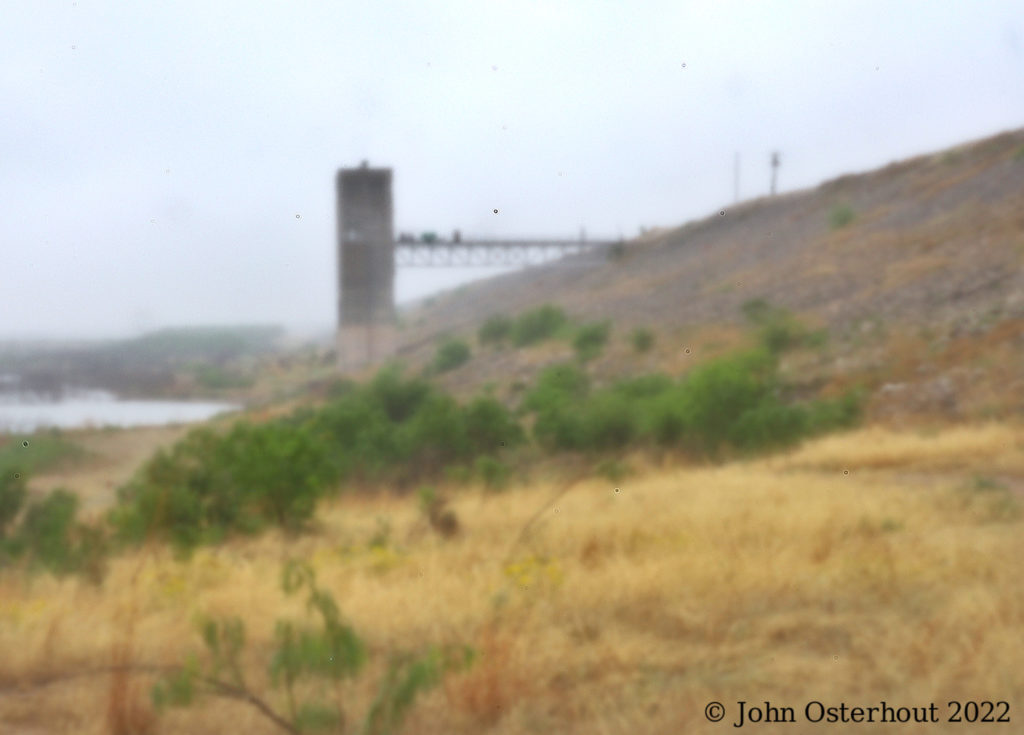
About what you would expect for 128mm vs 60mm. I cropped this shot to get:
Tower by the Dam (Final Crop)
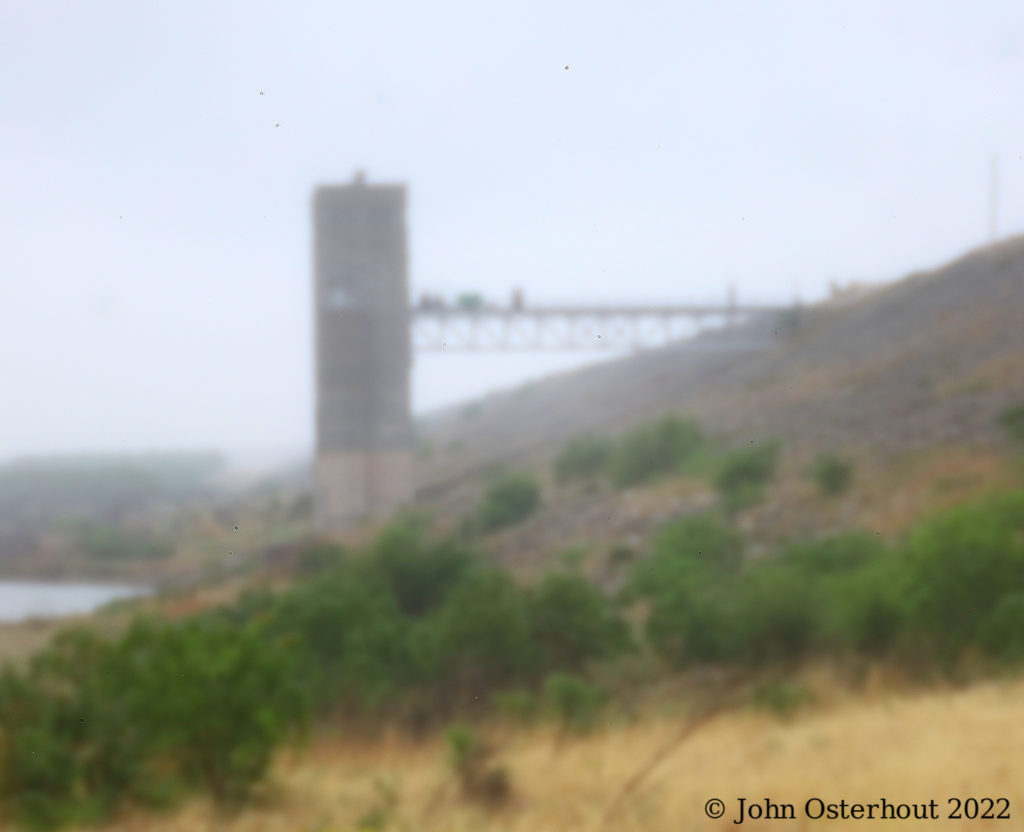
More Spooky Trees

Here is another “Spooky Trees” shot. These are some mesquite trees that had been in a fire. I don’t know for sure, but state park does controlled burns regularly. Of course, as dry as it’s been this might have just been the result of lightning.
O. C. Fisher Reservoir

Here is a shot of the O. C. Fisher Reservoir at 40mm on the Pinhole Pro X. The artificial lake was originally known as San Angelo Lake, but was renamed in 1875 for local congressman O. C. Fisher in honor of his 23 years of service in the U.S, Congress.
Iron Buffalo
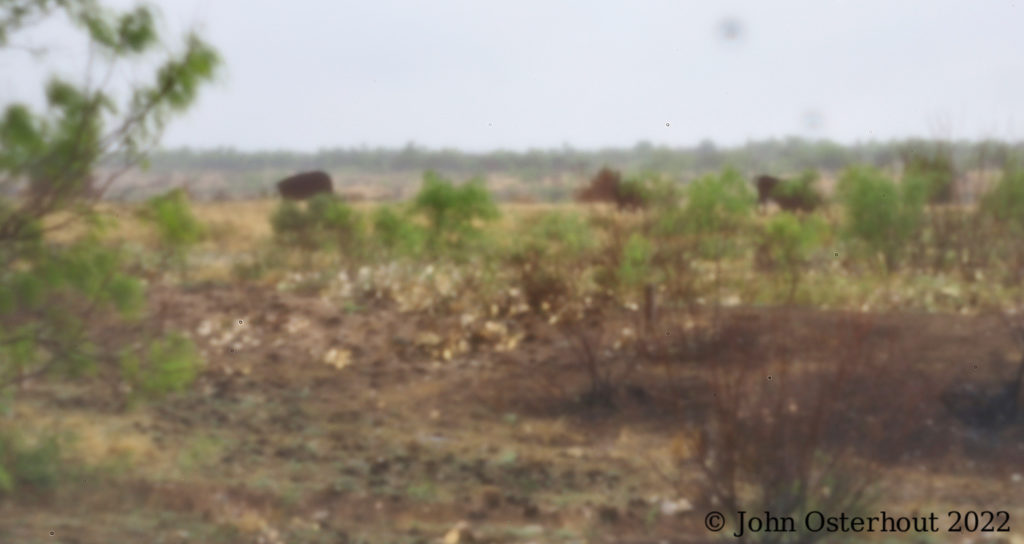
The final shot is of San Angelo State Park’s Iron Buffalo. Although there are real buffalo in the park, we didn’t see any during our expedition. I’ve shown the iron buffalo in a previous post, Five Frames from Walks in the Park. I thought a hazy pinhole shot of the buffalo might be just the thing. However, they look more like big turds than buffalo.
These photos were all taken with a Canon EOS RP wearing a Thingyfy Pinhole Pro X. Exposures were determined with the camera’s meter and I bracketed most of the shots. The photos were processed in Darktable, which is open source software available for Windoze and Linux.